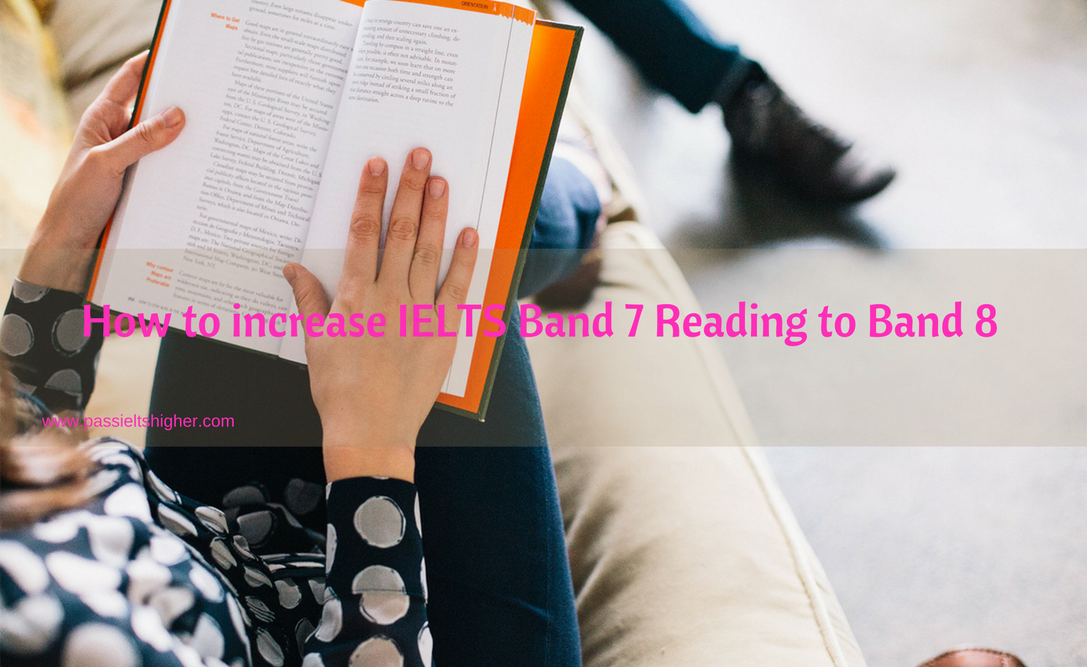In this article we are going to concentrate on improving your reading, so that you finally get the band 7 or band 8 that you need to be able to fulfill your dreams.
Most of my students do not get the band they need IELTS Reading. Here is a quick summary of my approach and techniques. More detailed information can be found in my ebook:
Cambridge IELTS 7 Reading Practice Tests Explained
Approaches to use for IELTS Reading Band 7 or higher
A) A good collection of key words and their synonyms or paraphrases
Followers of passieltshigher.com will already know the importance of having a very wide range and knowledge of key words and synonyms and paraphrases of these key words, as this is the most important knowledge to have to enable you to get a band 7 in any of the 4 skills.
The wider the range of your language, the easier the questions in the the reading and listening exams will be to answer, not to mention how much more fluent and skilful you’ll sound if you can then recycle this knowledge in your writing and speaking exams.
B) How to read and absorb necessary information to be able to answer the reading questions quickly
1) You need to be able to skim to absorb a general understanding of the text quickly.
2) You need to be able to scan to find details in the reading text quickly.
C) You need to know when it is important to skim for a general information from the text and when it is important to scan for details from the text.
1a) When to skim
Read the Text first
There are 4 types of IELTS Reading questions when I think it is a good idea to skim the text first, before you attempt to answer the questions. You need to do this paragraph by paragraph, as you won’t retain all the information if you try to read the text in one go.
The question types
1. Matching the Headings to the Paragraphs
2. Locating Information in the Paragraphs
3. Lists
4. Classification
1b) What to do
Matching headings to paragraphs
- Skim the first paragraph and make a sentence summary of that paragraph, first at the side of the paragraph but later, as you get better at doing this
- keep the sentence summary in your head, as you won’t have time to write sentence summaries in the exam.
The sentence summary needs to include what you think are the most important ideas in the paragraph, that is the key words.
Having made the sentence summary:
- look at the headings you have been given
- underline the key words in all the headings
- see which important words from the headings are paraphrases of any main ideas or key words in your sentence summary.
Once you have found matching phrases for all the key words from one of the headings in your sentence summary, that is your answer.
If any of the key words of the heading are not found in your sentence summary, you discard that heading until the next time.
Repeat the process with the next paragraph, until you have matched all the headings to the paragraphs.
Locating information in the paragraphs
Use the method for matching headings to paragraphs to locate the information in the paragraphs
Kick-start your IELTS Preparation. Stop making mistakes which lose you marks and learn how to earn more marks.
-
Downloadable Library
A Downloadable IELTS Preparation Library with advice covering all IELTS aspects
-
IELTS Test Prepcasts
Podcasts with transcripts improve Reading, Writing, Listening and Speaking
-
IELTS Test Articles
Grammar advice, sample IELTS Test questions and tips underpin learning
Free registration for access to the downloadable library and to receive notification each time we release new information, click the button to register
Lists (a mix of scan and skim)
This can be a list of names, or dates, or countries for example:
- Scan the whole text for the name,or the topic in the list (it might be mentioned twice). When you’ve found the name
- skim the paragraph around the name for the general idea of the paragraph and the key words, summarising this in one sentence.
- Then look at the statements (maybe questions)and find the key words in these. Which key words can you match from the statements with the paraphrases in your summary?
- Remember you need to match all the main ideas from the statement or you have chosen the wrong statement.
Repeat this with the rest of the names on the list.
Classification (a mix of scan and skim)
Here you are given lists of what can be included, what can’t be included , or a mix of both.
- Scan all the questions and find the key words in each question, so you know the classifications you need to find.
- Read the text paragraph by paragraph and summarise each paragraph in one sentence using the key words or paraphrases of the key words. (Note these down, or remember them.
- Read your first sentence summary and see if it contains any of the key words in the classification questions.
When you have found all the paraphrases from the paragraph in your question, you have the correct answer.
2a When to scan
Read the questions first
With all the other question types, you can read the questions first.
The Question Types
1. True/False/Not Given – Yes/No/Not Given
2. Any question with a gap fill:
- Sentence gap fills
- Summary gap fills
- Summary gap fills with a box
- Flow charts
- Table completion
3. Matching sentence halves
4. Comprehension questions
And any other question types you come across.
2b) What to do
- Read the first question and underline the key words.
- Scan the text until you find either the key words or their paraphrases.
- Read around these to get the meaning. This will lead you to the answer.
As long as all the key words from the question are found in the text, you will have the correct answer.
2c) Repeat the procedure
When you have found the answer to the first question, the answer to the next question is in sequence.
2d) A slight change in procedure
With questions like summary with a box and matching sentence halves, you need to:
- find the key words in the question
- scan for the key words or paraphrases in the text
- having found these you need to go back to the choice of sentence halves you’ve been given and find the paraphrases here, of the paraphrases you found in the text.
Easy Huh?
This becomes much easier with practice, so don’t despair.
Some of my students have got band 8.5 and 9 with this technique and lots of practice.
You can do the same
D) Improve your speed by putting the above approaches into practice
As with any IELTS Skill, the more you practise, the better you get.
Always remember that you should be making a list of key words, synonyms and their paraphrases as you study and practise.
The Reading exam becomes much easier if you have as many key words and their paraphrases at your finger tips as possible.
When you do, your reading speed will also improve automatically because you can match the questions to the answers much more quickly, easily and correctly
Band 8
This will happen naturally, as you note and learn all the key words and paraphrases from any practice you do because while you are investing so much time in practising, you’ll also automatically be picking up your reading speed, which will help you answer questions quickly and accurately enough to get the band 8 (or higher)
Kick-start your IELTS Preparation. Stop making mistakes which lose you marks and learn how to earn more marks.
-
Downloadable Library
A Downloadable IELTS Preparation Library with advice covering all IELTS aspects
-
IELTS Test Prepcasts
Podcasts with transcripts improve Reading, Writing, Listening and Speaking
-
IELTS Test Articles
Grammar advice, sample IELTS Test questions and tips underpin learning
Free registration for access to the downloadable library and to receive notification each time we release new information, click the button to register


Leave a Reply